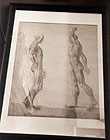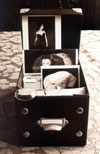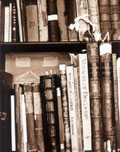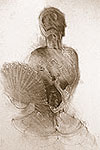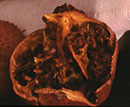THE COLLECTIONSAS PART OF A NESTA Dream Time Fellowship 2005/06, Jane Wildgoose has been photographing key Readers with 'significant objects' in a series of photographic portraits and still lifes that examine relationships between the material world and memory. With the help of BBC producer Neil McCarthy, Jane has conducted a series of interviews with Wildgoose Memorial Library Readers who have taken part in the project, and these are being edited into a radio piece by American playwright and radio producer Gregory Whitehead. THE LIBRARY IS ARRANGED in 10 main sections, each of which is named after titles in stock. The Keeper reserves the right to change section names from time to time, as new and apposite acquisitions are made. The following gives a broad outline of the content of these sections, and provides a brief indication of their scope:
 1. THE VITALITY OF DEATH: tracing the history and art of monumental sculpture, burial rites and funerary customs - from Ancient Egypt & Rome (also including Lindow Man & Bog People) to contemporary practice.

 3. OPUS SACRUM: visions, apotheosis, & religious artefacts.

 5. FLOWER PAINTING, STILL LIFE & THE ORIGINS OF MUSEUMS: a brief history of display, including mediæval herbals, seventeenth-century flower & vanitas paintings, and cabinets of curiosities.

 7. OBJECTS OF DESIRE: the history of interior decoration, from Pompeii & Herculaneum to the present day.
 8. KEY MONUMENTS OF THE HISTORY OF ART: a small A-Z of artists’ monographs, and works on the history of art, from Arcimboldo to Zurbarán.

 10. WHO IS SHE?*: A text in progress comprised of literary fragments collected from works in The Miss Havisham Archive, and collated into a narrative in five scenes. Who Is She? draws directly upon literary references that associate women with flowers, fruit and precious stones. Started in 1997, and originally intended as the script for a sound performance to accompany an installation and performance, Who Is She? is a meditation on the transience of life, beauty, and love. It takes the form of a collage of diverse text fragments collated to form a new narrative, and explores specific metaphors employed in the description of women at different points in their lives. The text of Who Is She? is unfinished, but continues to provide a reference point for Jane Wildgoose's ongoing projects - including Human Nature at Maidstone Museum, and A Rose Flowering by the Sea at Bexhill Museum of Costume & Social History. * "Who is she that looketh forth as the morning,
 The Wildgoose Memorial Library is dedicated to Persephone, who delighted herself in contemplating beautiful views, flowery meadows and limpid streams*.
The Library also offers a remedy to Orpheus, whose noble - yet ultimately tragic - attempt, to rescue Eurydice from the Underworld, failed: on account of his fatal incomprehension and doubt, and in consequence of which his beloved was consigned to darkness for Eternity.
 * J. Lempriere, A Classical Dictionary, containing a copious account of all the proper names mentioned in ancient authors with the value of coins, weights, and measures used among the Greeks & Romans & chronological table. (London: George Routledge & Sons, 1908). |
||||||||||
| Copyright Jane Wildgoose and The Wildgoose Memorial Library |
